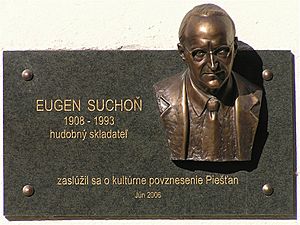Eugen Suchoň facts for kids
Eugen Suchoň (born September 25, 1908 – died August 5, 1993) was one of the most important Slovak composers of the 20th century. He created many famous operas, symphonies, and other musical pieces. His music often mixed traditional Slovak folk sounds with classical styles.
Contents
Early Life and Musical Beginnings
Eugen Suchoň was born in Pezinok, Slovakia, on September 25, 1908. Music was a big part of his family life. His father, Ladislav Suchoň, was an organist and a teacher. His mother, Serafína Suchoňová, taught piano. Eugen learned to play the piano from her.
Their home was always full of music. As a young child, Eugen would listen from under the piano when his father played with other musicians. This early exposure to music helped shape his future.
In 1920, when he was twelve, Eugen started formal piano lessons. He studied at the Bratislava School of Music with a well-known musician named Frico Kafenda. Later, from 1927 to 1931, he continued his studies with Kafenda at the new Academy of Music in Bratislava.
His first musical pieces included piano songs and a choral work called Veľky Pôst (which means The Great Fast). He finished his composition studies with a Sonata for Violin and Piano and a String Quartet. He also studied for two years at the Prague Conservatory with Vítězslav Novák. This training helped him become a very skilled composer.
During this time, Eugen Suchoň taught music theory in Bratislava. His music from this period often sounded like late Romantic music. It also used elements of folk modality and chromaticism. This means his music was inspired by folk tunes but also used many different notes.
One of his important early works was the male choral cycle O horách (meaning "Of mountains"). This piece helped create a unique Slovak national music style. Another big work was his cantata, The Psalm of the Sub-Carpathian Land (1938). He also arranged many folk songs. All these efforts led to his famous opera, Krútňava (The Whirlpool), which he finished in 1949.
Middle Years and Famous Operas
The opera Krútňava was a huge success. It helped establish modern Slovak opera and gained international attention for Suchoň. From 1948 to 1960, Suchoň worked as a professor. He was also the head of the Music Education Department at the Teacher Training College in Bratislava.
During these years, he composed other important works. These included the Fantasies for Violin and Orchestra and Metamorphoses for piano. He also wrote the Symphonic Suite for a large orchestra. Suchoň was very involved in teaching music and developing music education.
Another major work from this period was his second opera, Kraľ Svätopluk (meaning "King Svätopluk"). He finished this opera in 1959. This historical opera tells a grand story from the time of the Great Moravian Empire. It is a large and powerful work that shows Slavic themes. It ends with good winning over evil. The opera first played in Bratislava in 1960. It was also performed in Prague and Košice that same year.
Later Years and New Musical Styles
From 1959 to 1974, Eugen Suchoň taught music theory at Bratislava University. During this time, his musical style began to change. He started to use new techniques in his compositions, like serialism. This meant he tried different ways of organizing notes and sounds. He also used harmonies that emphasized 2nds, 4ths, and 7ths, leading to polymodality. This made his music sound more modern and complex.
His later works were mostly for chamber groups and orchestras. Some of these include the song cycle Ad astra (1961), based on poems by Štefan Žáry. He also wrote the mixed choir cycle O človeku ("about a human"). Other pieces were Poème macabre for violin and piano, and Contemplations for a narrator and piano.
He also composed Six Compositions for Strings and the Rhapsodic Suite for piano and orchestra. His Symfonická fantasia na BACH (1971) was another notable work. His piano cycle Kaleidoscope also has a version for piano, string orchestra, and percussion. His very last works included a Concertino for Clarinet and Orchestra, Elegy, Toccata, and the song cycles Glimpse into the Unknown and Three Songs for Bass.
Eugen Suchoň passed away in Bratislava in 1993.
Selected Works
Operas and Stage Music
- Music to Stodola's drama King Svätopluk (1935–36)
- Krútňava (The Whirlpool; 1941–49)
- Svätopluk (1952–59)
Orchestral Music
- Balladic Suite, op. 9 (1934–36)
- Psalm of the Carpathian Land (1937–38)
- Metamorphoses (1951–53)
- Symphonic Fantasia on B-A-C-H (1971)
- Concertino (1977)
Chamber Music
- String Quartet (1930–31, reworked 1939)
- Piano Quartet (1932–33)
- Six Pieces for Strings (1955–64)
- Kaleidoscope (1967)
Vocal and Choral Music
- Nox et Solitudo (1932)
- How Beautiful You Are (1932–33)
- From the Mountain (1934–42)
- Ad astra (1961)
Works for Children
- Pictures from Slovakia (1954–55)
See also
 In Spanish: Eugen Suchoň para niños
In Spanish: Eugen Suchoň para niños


